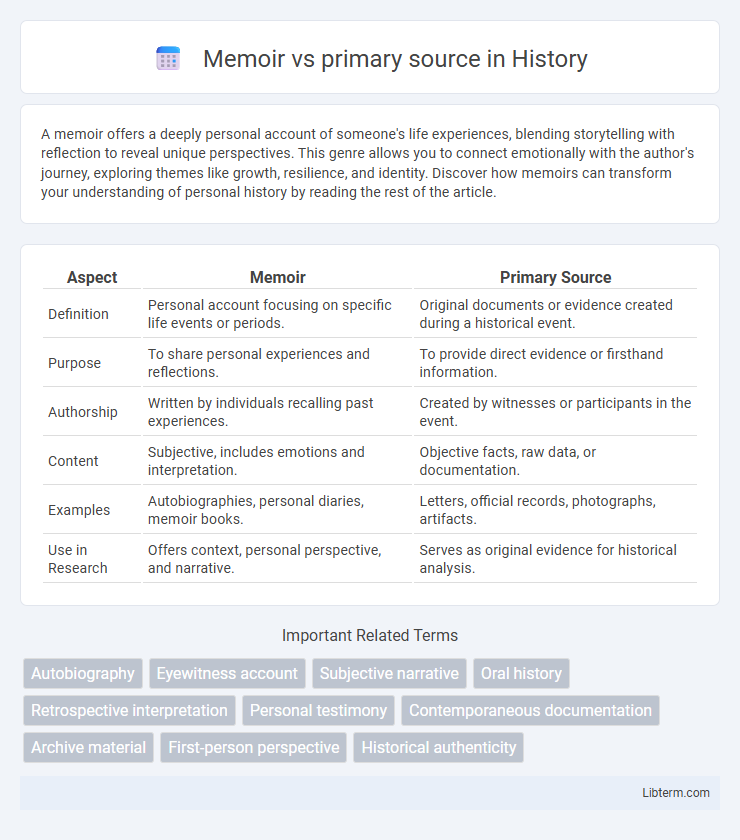A memoir offers a deeply personal account of someone's life experiences, blending storytelling with reflection to reveal unique perspectives. This genre allows you to connect emotionally with the author's journey, exploring themes like growth, resilience, and identity. Discover how memoirs can transform your understanding of personal history by reading the rest of the article.
Table of Comparison
| Aspect | Memoir | Primary Source |
|---|---|---|
| Definition | Personal account focusing on specific life events or periods. | Original documents or evidence created during a historical event. |
| Purpose | To share personal experiences and reflections. | To provide direct evidence or firsthand information. |
| Authorship | Written by individuals recalling past experiences. | Created by witnesses or participants in the event. |
| Content | Subjective, includes emotions and interpretation. | Objective facts, raw data, or documentation. |
| Examples | Autobiographies, personal diaries, memoir books. | Letters, official records, photographs, artifacts. |
| Use in Research | Offers context, personal perspective, and narrative. | Serves as original evidence for historical analysis. |
Defining Memoirs and Primary Sources
A memoir is a first-person narrative reflecting personal experiences and emotions, typically written retrospectively, emphasizing subjective interpretation and memory. Primary sources, by contrast, are original documents or artifacts created contemporaneously with the event or period being studied, offering direct, unfiltered evidence. While memoirs provide valuable insight into an individual's perspective, primary sources serve as foundational materials for historical research and verification.
Key Differences Between Memoirs and Primary Sources
Memoirs offer a personal, subjective narrative reflecting the author's memories and emotions, often written long after events occurred, whereas primary sources provide contemporaneous, factual evidence or firsthand accounts created during the time under study. Memoirs emphasize individual perspective and interpretation, while primary sources include a wide range of original materials like photographs, documents, diaries, and official records that serve as direct evidence. The key difference lies in memoirs' reflective, narrative style contrasting with the more immediate, unfiltered nature of primary sources.
Purpose and Perspective in Memoirs
Memoirs serve the purpose of providing a personal narrative that reflects an individual's memories, emotions, and subjective interpretation of past events, offering insight into their unique perspective. As a secondary source, a memoir emphasizes the author's internal experience rather than objective or contemporaneous documentation. This introspective viewpoint contrasts with primary sources, which aim to present factual, immediate accounts without the influence of hindsight or personal reflection.
Objectivity in Primary Sources
Primary sources provide direct, unfiltered evidence from the time of an event, enhancing objectivity through their firsthand nature. Memoirs, while valuable, often reflect personal bias and subjective interpretation, limiting their reliability as completely objective records. Researchers prioritize primary sources for factual accuracy and original context essential in historical analysis.
Reliability: Memoir vs Primary Source
Memoirs offer personal reflections and subjective interpretations, which may introduce bias or selective memory, affecting their reliability. Primary sources, such as official documents or eyewitness accounts, provide direct evidence from the time of the event, making them generally more reliable for factual accuracy. Researchers often cross-reference memoirs with primary sources to validate information and gain a comprehensive understanding.
Examples of Memoirs and Primary Sources
Memoirs such as "The Diary of Anne Frank" and "Night" by Elie Wiesel provide personal reflections and interpretations of historical events, offering subjective insights into experiences. Primary sources like official documents, photographs, letters, and government records serve as original materials created at the time under study, providing direct evidence about the past. While memoirs blend memory with narrative, primary sources remain unfiltered raw data used for historical analysis.
Analyzing Bias in Memoirs
Memoirs often present subjective interpretations influenced by the author's personal experiences, emotions, and selective memory, leading to potential bias. Unlike primary sources such as official documents or contemporaneous records, memoirs may emphasize certain events or perspectives to shape a narrative. Analyzing bias in memoirs requires cross-referencing with multiple primary sources to discern factual accuracy and separate individual perception from historical reality.
Using Primary Sources in Research
Primary sources provide firsthand accounts and original evidence essential for accurate historical research, while memoirs offer personal reflections that can complement but may introduce subjective bias. Researchers prioritize primary sources such as letters, official documents, or eyewitness reports to establish factual foundation and authenticity in academic work. Memoirs serve as valuable supplementary materials for understanding individual perspectives and contextual nuances within the broader historical narrative.
When to Choose a Memoir Over a Primary Source
Choose a memoir when seeking personal insights, emotional depth, and individual perspectives that primary sources may lack. Memoirs provide reflective narratives, revealing the author's subjective experience during historical events. They are ideal for understanding personal motivations and cultural context beyond factual records found in primary sources.
Integrating Memoirs and Primary Sources in Historical Analysis
Integrating memoirs and primary sources in historical analysis enriches the understanding of past events by combining personal narratives with contemporaneous evidence, offering a balance of subjective experience and objective context. Memoirs provide detailed insights into individual perspectives and emotions, while primary sources such as letters, official documents, and photographs supply factual corroboration and broader societal frameworks. Effective historical research synthesizes these materials to construct a nuanced interpretation that acknowledges both personal memory and documentary accuracy.
Memoir Infographic

 libterm.com
libterm.com